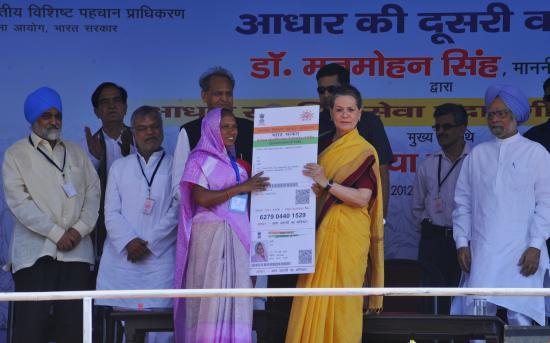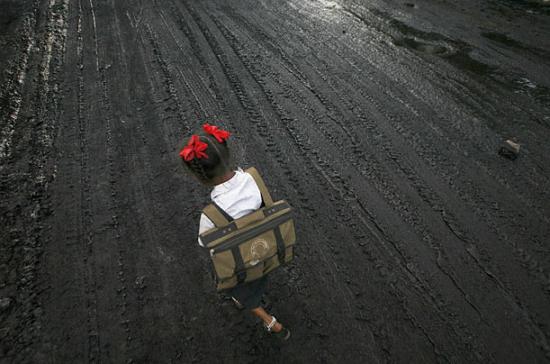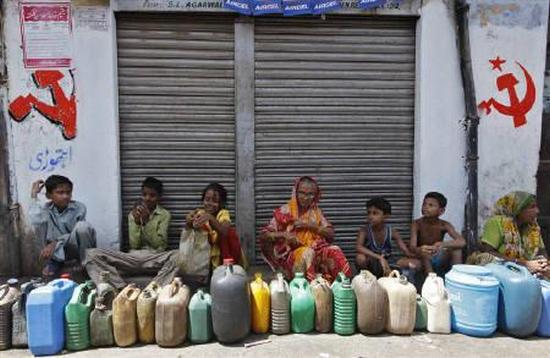Photographs: Kind courtesy, UIDAI Shubhashis Gangopadhyay
The UID scheme can help in implementing government programmes effectively by cutting down expensive and time-consuming paperwork.
The central government is seriously thinking of putting in place a technology-based platform to hand over subsidies directly into the hands of their intended beneficiaries.
A number of pilots are under way for handing over, for example, kerosene subsidies for household consumption. While this is largely a central government initiative, state governments too have many subsidy programmes in which technology can be used.
A couple of years ago, India Development Foundation investigated the various social welfare schemes of a typical state government.
They identified at least 110 schemes administered by 12 separate departments that were, essentially, some form of cash-transfer programmes. These transfers were both conditional and unconditional, but almost always were targeted at particular sections of the population.
Closer examination revealed that many of these schemes were trying to achieve different parts of the same broad objective.
For instance, there were schemes that subsidised the purchase of textbooks for the children of poor families, the purchase of school uniforms and the costs of transport to and from school. The common objective was to educate the children.
Observe that all three are necessary for a child to be educated. It makes little sense to get children to school when they cannot access textbooks, or give them school uniforms when they cannot bear the costs of being transported to school.
Add to this the fact that Indian girls are generally anaemic and require nutritional supplements. There are government schemes to provide for that also.
To achieve the objective of improving the general welfare of the girl child, both education and health are necessary. While the education subsidies are under one department, the health subsidies are under another department.
...
Aadhaar can help plug leakages in govt programmes
Image: A girl walks on a road covered with oil and soot in an industrial areaPhotographs: Arko Datta/Reuters
This leads to duplication of effort in two ways. Consider the same potential beneficiary (the girl child in a poor family) of two schemes, A (school textbooks) and B (nutrition supplements).
Different authorities implement different schemes. The eligibility requirement for A (poor and child) is further refined for B (poor, child and a girl). As it happens now, a girl child has to provide documentation separately for each of the schemes.
Thus, beneficiaries of scheme B have to provide the same set of information they did while availing A and some more. This is unnecessary, as the information relevant for availing scheme B should be the incremental ones collected over and above those provided while availing A.
Replication also occurs in terms of administrative costs since both authorities of A and B are holding on to common pieces of information (poor and child).
Such duplication is common when different schemes are administered by different departments, all following the same procedures and collecting the same information to provide different parts (education and health) of the same objective (improving welfare).
Of course, all of this affects the costs of implementing a scheme. Recall the famous statement that for every rupee spent by the government, only 15 paise reach the beneficiary.
While part of this loss is due to leakages, a significant part of this is the cost of delivery. It is, therefore, common for the debate surrounding any new scheme to focus on the cost of implementation and the benefits resulting from the scheme.
...
Aadhaar can help plug leakages in govt programmes
Image: Residents wait outside a closed ration shop with their empty containers to collect kerosene in KolkataPhotographs: Rupak De Chowdhuri/Reuters
However, a simple cost-benefit approach may not be the most appropriate framework for deciding on social welfare schemes. First, it is extremely difficult, if not impossible, to measure the benefits associated with development schemes that enforce basic rights.
This is because the benefits (i) often show up after a considerable time period; (ii) are essential; (iii) generate social values that are often unquantifiab#8804 and (iv) have huge spill over effects.
Such spillover effects are important. For example, lack of education affects adversely not only households who are deprived of it, but also society as a whole - for example, the lack of skilled workers and possible social unrest.
Measuring the benefits of a programme without taking into account such spill over effects severely underestimates the benefits.
A more rational approach could be to shift the focus on how to improve the access of beneficiaries to schemes that aim for certain social outcomes.
This would imply preventing duplication of effort in their implementation and making it easier for potential beneficiaries to identify, and authenticate, themselves to the government.
In other words, instead of focusing on the government and its ease in functioning (something that the cost-benefit approach usually ends up doing), one should focus on the intended beneficiaries and their ease in accessing these programmes.
...
Aadhaar can help plug leakages in govt programmes
Image: A girl walks past Aadhaar postersPhotographs: Kind courtesy, UIDAI
With UID and Aadhaar, such a change in focus becomes possible. A child is born, the birth is registered, a number is given.
If it is a girl, then six years from now she will go to school and require textbooks, uniforms and transportation; 12 years from now she will reach puberty and nutrition supplements will become necessary; 18 years from now the girl will reach adulthood and the cash transfer promised by many state governments will become due.
Once the baby is in the government database, and that is what happens when the birth is registered, why does the girl child have to prove her credentials at each stage?
A digitised database can be set up to automatically flag when the child becomes eligible for various programmes as she keeps growing.
And this database can be accessed by both the education and the health department. The cash transfers due can be automatically transferred to the Aadhaar account.
One overhead - the database, its maintenance and the software - can be used by all state government departments involved in various social welfare programmes.
If these programmes are targeted by economic status, one agency needs to verify that and put it into the database. This is where we need technology and Aadhaar.
The writer is research director at IDF and director of the School of Humanities and Social Sciences, SNU






article